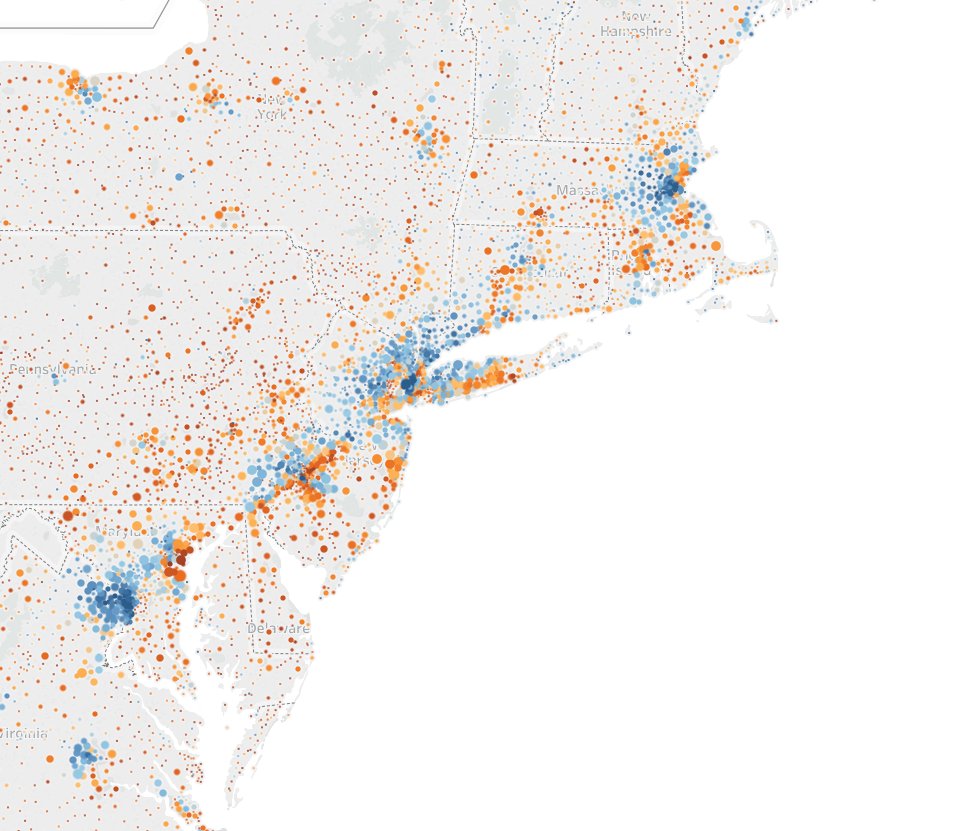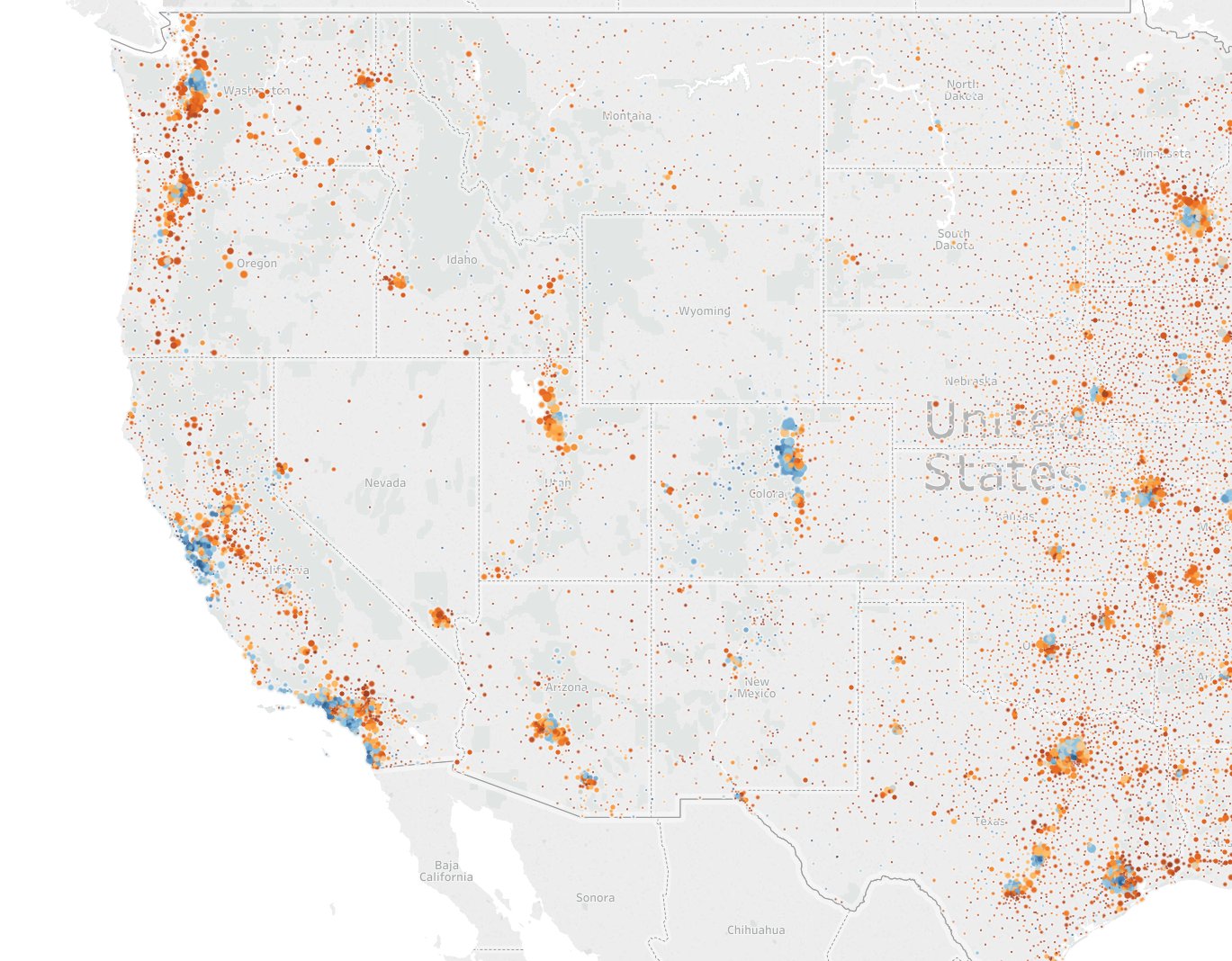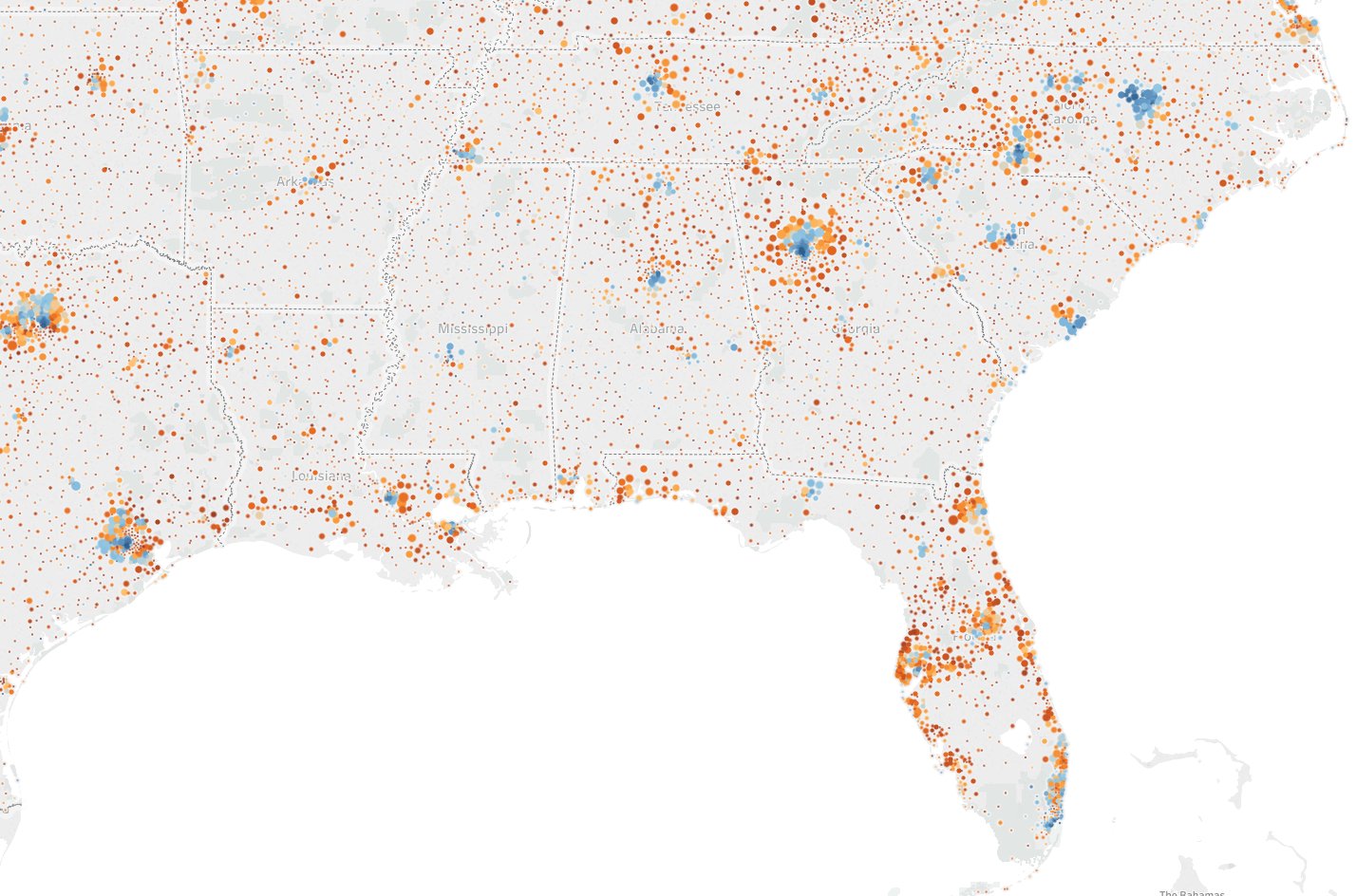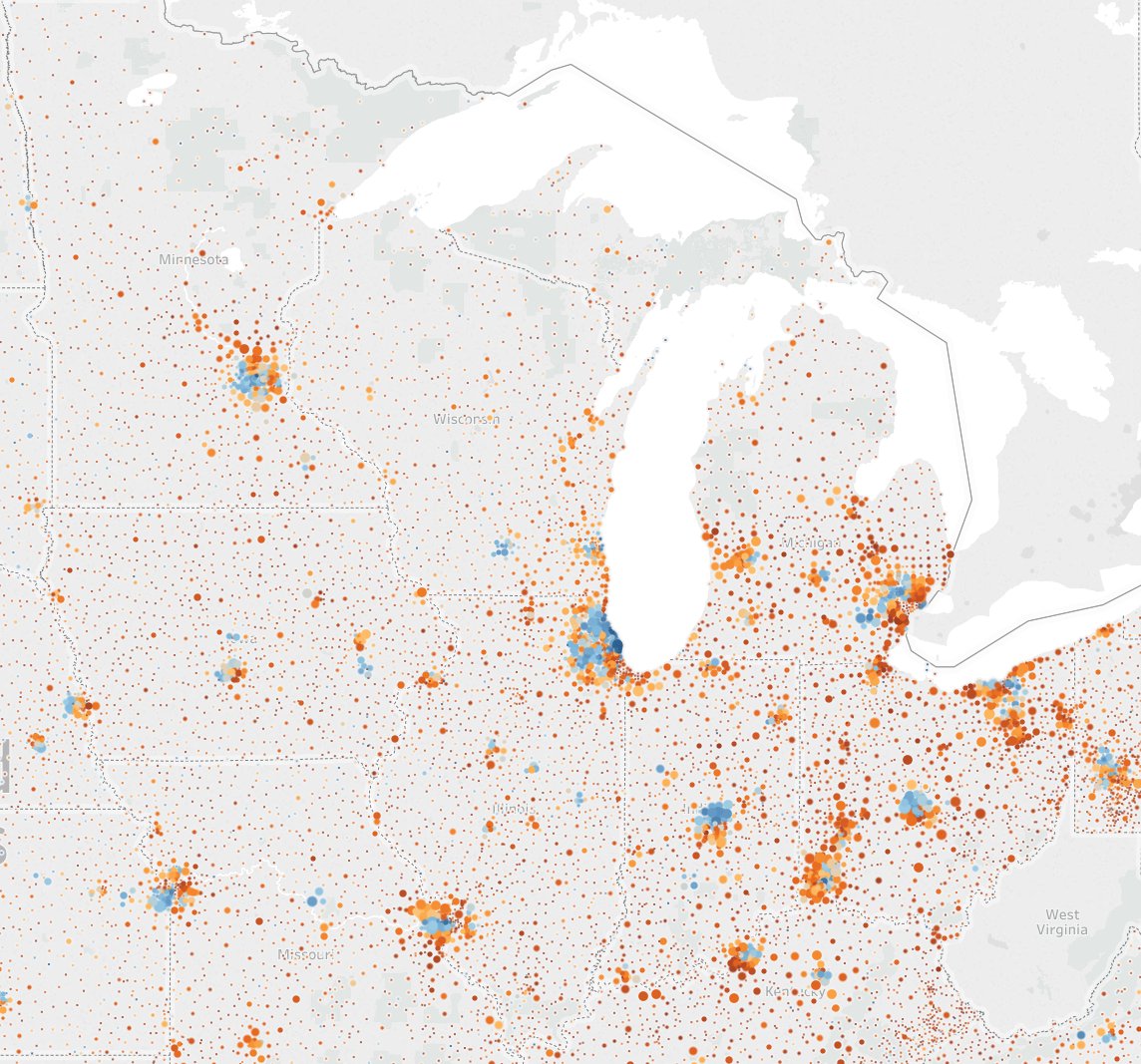 There is some concentration of educated millennials in Chicago, but it looks less blue (educated) than the Closed Access cities. Chicago doesn't really qualify as a Closed Access city - they build a decent number of homes and rents and prices aren't crazy. Chicago is sort of an interesting city. It has its problems. But, it has the advantage of density still as a draw. How much of the decline in crime in the Closed Access cities is related to their exclusive housing policies and the massive outmigration of their poor and less educated residents. Is Chicago suffering more from our current sources of social strife because they didn't passively kick out the riff-raff like the other major cities?
There is some concentration of educated millennials in Chicago, but it looks less blue (educated) than the Closed Access cities. Chicago doesn't really qualify as a Closed Access city - they build a decent number of homes and rents and prices aren't crazy. Chicago is sort of an interesting city. It has its problems. But, it has the advantage of density still as a draw. How much of the decline in crime in the Closed Access cities is related to their exclusive housing policies and the massive outmigration of their poor and less educated residents. Is Chicago suffering more from our current sources of social strife because they didn't passively kick out the riff-raff like the other major cities?Washington, DC has the most extreme concentration of educated millennials. Washington isn't a Closed Access city. Rents are high, but they aren't high as a proportion of incomes. In Washington, the high incomes come from political rents and those incomes are used to bid up rents, as opposed to the Closed Access cities, where incomes are from competitive industries, but workers have to spend those incomes on uncomfortably high rents in order to have access to those industries.
 In California, the large scale segregation is clear here. The educated millennials have filled in the coastal metropolises, except for a few of the worst parts of LA. And, those without degrees have been pushed out to the Inland Empire.
In California, the large scale segregation is clear here. The educated millennials have filled in the coastal metropolises, except for a few of the worst parts of LA. And, those without degrees have been pushed out to the Inland Empire.In the south, there is a concentration in the Research Triangle in North Carolina, but there aren't any Closed Access MSAs in the south. Florida generally has a low concentration of education, which follows along with the migration patterns I have found. It appears to serve the same function for the Northeast as Arizona, Nevada, and the Inland Empire do for the West - the main destination for out-migrants who are priced out of the entire Closed Access regions.
 One takeaway that I think these visualizations help to notice is that these cities don't have high incomes and high levels of education because of their local education policies. It's not like there aren't universities in the rest of the country and these cities are sending all of their public school children to local colleges.
One takeaway that I think these visualizations help to notice is that these cities don't have high incomes and high levels of education because of their local education policies. It's not like there aren't universities in the rest of the country and these cities are sending all of their public school children to local colleges.Americans are being educated across the country, and then, they are moving to the Closed Access cities after they are educated. To a certain extent, that has always been the case. What has changed is that this has become even more pronounced. And, these cities used to be centers of working class opportunity, too. But, they aren't any more. They are now sources of working class stress, and they keep dumping hundreds of thousands of stressed working class households on the rest of the country instead of being a source of working class opportunity.
I touch on this in the book. Autor, Dorn, Hanson, et. al. have been publishing research about labor rigidities that have left many communities stagnant. They blame the loss of manufacturing to Chinese competition. But, why did previous generations of displaced laborers not suffer the same rigidities? Why is China different?
I think the reason is that (1) much of the trade deficit is a product of the closed access housing problem because American firms earning economic rents from the limited access orders in those cities are earning excess profits on foreign revenues. Those profits fund the trade deficit. And (2) the natural economic healing that should happen in the face of economic dislocations is blocked by Closed Access housing. When the transition out of agriculture happened, working class laborers moved to the cities to work in factories. Today, the same transition would happen, but they would be moving to the cities to work in non-tradable sectors - service sectors (including residential construction!). But, today, they are outbid for the limited housing, so we are imposing labor market rigidities on our most vulnerable communities.

So silly question:
ReplyDeleteWhat happens when all the 20-somethings become 30 and 40-somethings with families?
Because right now, moving to SF/NYC/wherever and getting a couple roommates while you get started makes sense. Once you need to make a mortgage on a 3BR house instead of half the rent on a 2BR apartment, it doesn't.
What exactly is the Closed-Access exit strategy here?
I think you have to be careful about thinking narratively. There are inflows and outflows for each age group. There are a lot of moving parts. A question like this picks one moving part and sort of implies ceteris paribus about all the others.
DeleteThat said, some of the pressure on urban housing may be from the relatively large size of the 20 something demographic. Maybe this has something to do with the parallels between the 2000s and the 1970s regarding home prices, rents, and real interest rates. But, the demographic issues are probably small. I think the extreme scale of the problem now is mostly due to the sustainably high incomes that limited access highly skilled information workers and firms can capture.
There are inflows and outflows, but the current cohort is about 15% larger than the cohort 10 years behind it.
Deletehttps://populationpyramid.net/united-states-of-america/2016/
"I think the extreme scale of the problem now is mostly due to the sustainably high incomes that limited access highly skilled information workers and firms can capture."
Right, and when I'm only paying an extra $2000/month for an apartment, sticking around SF makes sense.
What happens when I'm being forced to pay an extra $8,000/month in mortgage and property taxes (plus taxes on the income so I can pay my mortgage)? And CAN'T get home at 8:00 at night anymore because I have kids in school with after-school activities.
It's absolutely reasonable to expect Google to pay me an extra $50K/year to keep me in network effects. It's unreasonable to expect $200K.
You're right. It is an issue. That family probably takes a pay cut and moves to a city where they are less productive. That's happening now. It will probably have a macro-effect on the margin because of the population bulge, as you point out. I just think it's a small piece of the story, in terms of the scale of the effect.
DeleteIt's a good question. There will be several answers, each at the margin. Some 40 year olds will move further out - perhaps to commute in, but perhaps for another job. Some pay will have to rise to keep the then senior employees in their 30s and 40s. Companies will relocate. Automation will replace workers. Outsourcing will occur. The market will repond in those ways and many others.
DeleteFascinating post.
ReplyDeleteThe biggest structural impediment today in the U.S. economy is probably property zoning. Who is talking about it?
I would add that the criminalization of push-cart and truck-vending is the second-biggest structural impediment, except the people who would benefit basically go uncounted. Although consumers would benefit also.
Ben,
DeleteI think you need to add occupational licensing to cart & truck vending. Whenever the state puts hurdles in the way of people working for themselves, hurts us all.
Chuck--agreed.
ReplyDeleteChuck--agreed.
ReplyDelete